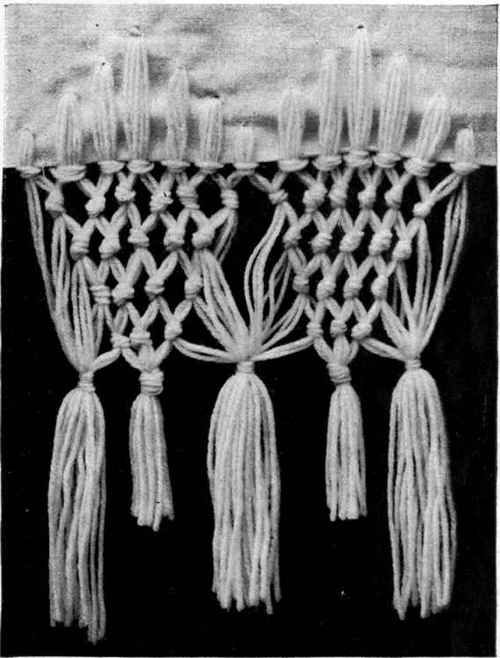Still, it's important to our mental health for us to have a bit of time we can devote to doing something we love. The old saying had it "All work and no play makes Jack a dull boy." (Of course, all play and no work can have even more disastrous results, but that's another story.)
If costuming is your love, you won't be able to bring a huge sewing project with you wherever you go. It's impractical, and people will give you suspicious glances. However, one overlooked aspect of costuming is accessories. Some of these are highly portable, attract favorable rather than displeased attention, and will get your costume farther along. Here are some suggestions:
Lace handkerchiefs.
- Whether or not you make your own lace, you can bring a small square of linen with you. The rest of your supplies will include either pre-made lace and a needle with matching thread, or, if you're a tatter, a tatting shuttle and reel of cotton.
- Handkerchiefs were an important part of life before the invention of facial tissue, and whether or not you use it according to its original purpose, your outfit will be more complete with a "hankie." Be sure to match the style and size of lace to your costume period and Sumptuary Laws, if they exist in the time frame. Some earlier reenactment periods don't allow for lace.

Lap quilt.
- You can't bring a huge quilting frame with you everywhere you go, but you can bring a quilting hoop to work on individual squares that you can sew together later. Georgia Bonesteel's excellent books and programs on the concept of Lap Quilting changed the way a lot of people quilt, including me!
- It may seem counterintuitive to say you can have more time for quilting if you hand-piece rather than sew by machine, but if you have little time to sit down and sew and lots of time when you're having to wait for something (say, in a doctor's office, at the garage getting your car repaired, etc.), it can be an easy way to get time to quilt into your day!
- Even if you machine piece the top first, you can still bring individual squares with you to hand-quilt with a relatively small quilting or even an embroidery frame.
- The added benefit of hand-piecing is that you can bring it safely to a reenactment without fear of modern techniques being ridiculed by the purists.

Gloves.
- Gloves are appropriate in many time periods, and are small enough to work on while on break, in a waiting room, etc.
- Gloves can be hand sewn of fabric or fine glove leather (which will be very thin and pliable).
- Gloves may also be knitted or crocheted. I've even tatted gloves, though it's more of a challenge and not for beginning tatters. A combination of techniques may be used. I haven't tried hairpin lace yet, but I'm sure it could be beautifully combined with other needlework to make amazing gloves.
Socks and stockings.
- If you're truly adventurous and a good knitter, you can bring a sock or stocking pattern with you, along with the appropriate needles for knitting in the round.
- Silk stockings can be cut out of the silk at home and then hand sewn, which could be done anywhere.
- You can embroider "clocks" onto silk stockings that haven't had their back seam sewn yet, and have an appropriate and much less expensive addition to your 18th Century costume.
Scarves, shawls and cravats.
- Scarves and shawls have gone in and out of favor over the centuries, but for those time periods where they are popular, they make a great accessory.
- A scarf can range anywhere from 14 inches square (roughly 35.5 cm) to the long, narrow versions in favor with early twentieth century pilots.
- Shawls vary in shape and size from the very small (which can sometimes mimic a Bertha collar) to ones large enough to wrap around you twice.
- Cravats should be of fine, crisp linen, which you should cut outwoven or sewn. beforehand and then can hem using the rolled handkerchief hem technique.
- Scarves and shawls can be knitted, crocheted,
- A popular pastime in the Georgian and Regency periods in England was "knotting a fringe" for shawls. This was macrame, pure and simple, and could be a small enough project to carry with you. The original fringes were most likely of silk. While the cost would be prohibitive for many of us, rayon threads would make an acceptable substitute.

I'm sure there are other accessories one could make that have small enough parts to bring along with you. I didn't mention beadwork, because if the beads get away from you in a crowded room, you'll never manage to recover them all! Any kind of jewelry making is also best done at home or in your workshop, if you're blessed enough to have one.
I hope today's blog will inspire you to find something portable to work on while you're away from home, or while you're at home entertaining company. Who knows, your friends might like to join you in starting a small project of their own!



Hi Marion! I always love reading your posts. I've wanted to write a historical, and what you stated here has been good for me to consider! I've always love Tatting. I have some old hankies made from family members long gone. If I had time that is one skill I would love to learn. :) I appreciate your posts! Blessings to you and yours!
ReplyDeleteThank you so much! I'm glad to be able to help! :) Tatting is actually fairly easy, and it's SO portable! Maybe I can do a how-to post in the next week or two on beginning steps in tatting.
ReplyDelete